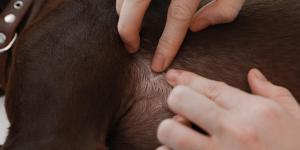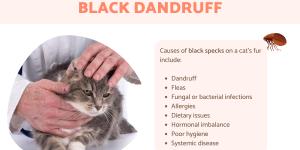My Cat Has Black Spots on His Lips and Nose



See files for Cats
When kittens are born, they are not the same color they will be when they become adult. Even their eyes are not usually the same since all cats are born with blue eyes. Only later will different pigments develop. However, after 12 to 18 months most cats should be the color they will be for the rest of their lives. If there are any changes to their skin color, it is uncommon. This is the case if we start to see black spots develop on parts of the cat, specifically the nose, eyelids, gums, lips or ears.
This AnimalWised article explains why your cat has black spots on their lips and nose. The main reason for this is due to something called lentigo in cats, a condition which is not dangerous. However, we should always take them to a veterinarian in case there is a less benign reason for black spot development.
What is lentigo in cats?
Lentigo (lentigo simplex) is an dermatological process characterized by the formation of one or more black or dark spots on a cat's skin. These spots are called macules and they present at the point of skin where the dermis and epidermis meet. We can see these spots in areas with little fur, which is why we can see black spots on their nose and lips.
These lesions consist of an accumulation of melanocytes (melanocytic hyperplasia), the cells that accumulate the pigment called melanin in the cutaneous basal layer. Melanin is responsible for all dark colors in a cat's skin, the only cats with a complete absence of melanin are albino cats. The melanocytes do not cause any thickening of the skin, but they do create visible black spots.
The most commonly affected areas by lentigo in cats are:
- Nose
- Gums
- Eyelids
- Ears
- Lips
This is a completely benign process which is asymptomatic, except for the presence of black spots themselves. Some breed standard agencies may not allow for these black spots in cat shows, but they are not aesthetically a problem. More important is that the cat can be perfectly healthy and happy if they have lentigo.
Another aesthetic change to a cat's nose can happen if their skin turns lighter. We explain more in our article on why your cat's nose has turned white.
Causes of lentigo in cats
Lentigo is a genetic disorder with autosomal recessive inheritance. It has been thought that a papillomavirus may be involved in canine lentigo. A biochemical relationship has also been found between post-inflammatory hyperpigmentation and inflammatory reactions that can cause lentigo, but there is insufficient evidence to support these hypotheses.
When it occurs in cats, it is usually seen in cat breeds with a ginger, orange or cream coat. The exact pathogenesis has not been established, beyond it being heredity. We can see this in white, black and orange cats, otherwise known as calico cats. In regards to age, they usually appear in younger or older cats.
Is lentigo in cats contagious?
No, lentigo is not a contagious disease as it is not caused by any microorganism. It is a totally individualized process that only appears according to the genetic inheritance of the feline.
Symptoms of lentigo in cats
We need to be vigilant with any changes to our cat's organism. Some may simply be a consequence of age, others may be superficial changes such lentigo, but there is always the risk of a pathological cause. When see our cat has black spots on their nose, lips or other mucus membranes, we should take note. If they are an orange or ginger cat, we can think these black spots are most likely due to lentigo. The same applies to calico cats with dark spots.
There are other causes about which we need to be vigilant. If you see black spots on your skin and hair of your cat's chin, it is possible they have feline acne. This may be caused by stress, allergies or poor hygiene. Also, if we see dark spots moving in the cat's fur, it is possible they have black dandruff, a type of parasitic infestation.
Macules caused by lentigo are not purulent or malignant. They will develop and may grow over time. For this reason, we need to be careful to differentiate them between melanoma, sarcoma or other types of feline skin cancer. These are dangerous and we need to have a veterinarian diagnose lentigo to ensure it is the underlying cause.
Below you can see what the black spots on a cat's nose and lips look like if they have lentigo.

Other reasons your cat has black spots on their nose and lips
The diagnosis of lentigo in cats is simple. The veterinarian will examine the black spots on the nose, ears, eyelids, gums or lips. However, it must always be differentiated from other diseases that can be confused with this process, such as:
- Melanoma
- Superficial pyoderma
- Demodicosis
- Feline acne
The definitive diagnosis is based on taking biopsy samples and sending them to the laboratory for histopathological analysis. This analysis will show an abundance of cells with melanin pigment (melanocytes), but not cancerous cells.
It must be taken into account if these lesions are modified in relation to their size, shape, elevation or appearance of spots in an area other than those indicated, as melanoma should be considered. This is a malignant cancerous process with a much worse prognosis. In this case, histopathology will also show the definitive diagnosis.
Also, lentigo will not cause the cat's nose, lips or other skin areas to scab. If pus, blood or scabs appear, it is likely a pathological problem. Discover more about possible feline skin problems with our article on why your cat has scabs.
Treatment of lentigo in cats
Lentigo in cats has no treatment as it is not necessary. It does not alter the cat's quality of life in any way. While in human medicine, thermal abrasion has been used in order to eliminate these lesions, it is not something carried out in feline veterinary medicine.
Lentigo cat prevention is not something we can provide. If it develops, it is due to a genetic inheritance and not something we can avoid with vaccination or deworming. These are still important aspects of a cat's care, but they are unrelated to lentigo in cats.
Taking any action against lentigo is a cause of unnecessary stress and suffering for our kitten. Humans may be self-conscious and want black spots removed due to cosmetic reasons, but your cat will not care. They will continue to be beautiful, happy and healthy cats with the same quality of life, with or without black spots on their nose and lips.
Although not related to lentigo, some cats have natural black spots on their fur markings. See examples of these felines with our list of domestic cats with spots.
This article is purely informative. AnimalWised does not have the authority to prescribe any veterinary treatment or create a diagnosis. We invite you to take your pet to the veterinarian if they are suffering from any condition or pain.
If you want to read similar articles to My Cat Has Black Spots on His Lips and Nose, we recommend you visit our Skin problems category.
- Machicote, G. (2011). Canine and feline dermatology. Servet.
- Harvey, R. G., & McKeever, P. J. (2001). Illustrated manual of skin diseases in dogs and cats. Grass editions.






